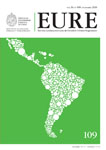Living in a Í€œcampamentoÍ€. The road to formal housing or a localiization strategy to address vulnerability?
DOI:
https://doi.org/10.4067/S0250-71612010000300005Keywords:
campamentos, localización, política habitacional, segregaciónAbstract
Based on a comparative survey of shanty towns and Í€œsocial housingÍ€ complexes in the Metropolitan Region of Santiago, we characterize the decision to live in campamentos (shanty towns) as combining two, usually mutually exclusive, goals: an improvement in location within the city, and access to more formal housing. The fact that campamentos persist in spite of the massive production of state-subsidized dwellings, and that most of their residents are above the poverty line, support this contention. Campamentos do not fit the common idea of groups of poor households who have occupied land illegally as the only residential alternative and as the means of securing ownership of a formal Í€œsocial housingÍ€ unit. This situation, unexpected by many, represents a challenge to current housing policies which tend to agglomerate social housing in the urban periphery, forming vast socially homogeneous or segregated urban districts where a ghetto phenomenon becomes embedded.Downloads
Published
How to Cite
Issue
Section
License
Copyright (c) 2010 Revista EURE - Revista de Estudios Urbano Regionales

This work is licensed under a Creative Commons Attribution 4.0 International License.
Al momento de aceptar la publicación de sus artículos, los autores deberán formalizar la cesión de derechos de autor a EURE, según las condiciones establecidas por la Revista.
Ésta establece que el autor autoriza a EURE de manera gratuita, exclusiva e ilimitada a reproducir, editar, publicar, distribuir, publicitar, comercializar y traducir el artículo, a cualquier soporte conocido o por conocer y desarrollar.
Del mismo modo, los autores aseguran que el artículo propuesto es original, no publicado y no propuesto para tal fin a otro medio de difusión.


